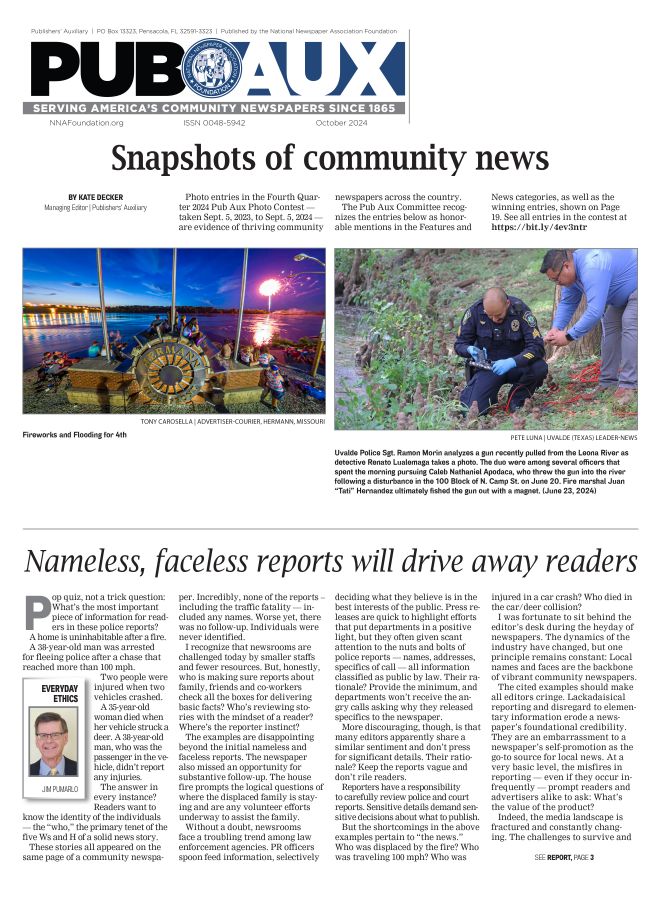The First Amendment and the power of 'fear'
Jul 6, 2015
By Gene Policinski
Inside the First Amendment
President Franklin D. Roosevelt once said that "the only thing we have to fear is fear itself." In a world wracked by terrorism, that carries even more meaning today.
When FDR spoke those words in 1933, the threat was the economic and social impact of the Great Depression. Today, it's the always-present threat of terrorist attacks that provokes deep-seated fear among Americans — with the target being our society and our freedoms.
The 2015 State of the First Amendment survey being released today is the latest in the annual sampling conducted since 1997 by the Newseum Institute's First Amendment Center. The survey checks public knowledge and opinions about our core freedoms of religion, speech, press, assembly and petition.
This year's survey results — based on phone interviews with 1,002 adults nationwide in mid-May — offers more proof that fear can put at risk our most cherished freedoms to believe, say and write what we will, and our ability to seek change in how our government operates.
In 2014, just weeks after the terrorist bombings at the Boston Marathon, 38 percent of respondents to the survey said the First Amendment "goes too far in the rights it guarantees." This year, that figure fell to 19 percent — noteworthy in itself, but also an echo of the survey's findings in the years following the 2001 terrorist attacks.
In 2002, about eight months after 9/11, the survey found that the number of Americans who thought we had too much freedom stood at 49 percent — only to drop to 39 percent in 2003 and as low as 13 percent in 2012.
And here's where we need to be fearful of the impact, power and influence of fear.
We know that from almost the beginning of the republic, threats to public safety and national security have caused us to accept laws and executive action that we've later rejected, repudiated and even recoiled from. Just seven years after the Bill of Rights was ratified in 1791, Congress cited fears of inciting a war with France in adopting the Sedition Act, which forbade criticism of Congress and the president. The act was used to jail 18 editors, but produced such negative national reaction it was allowed to lapse just two years after going into effect.
President Abraham Lincoln is known for protecting and expanding freedom — but he jailed editors, closed as many as 200 newspapers critical of the Union and his policies, and suspended other rights, saying these actions were necessary to win the Civil War.
Fears during World War II resulted in roundups, internment and, often, the loss of property and businesses of more than 100,000 Japanese Americans. In 1988, President Ronald Reagan signed the Civil Liberties Act, offering the nation's apology and compensation to those who were incarcerated in internment camps during World War II.
The intersection of fear and official reaction is the constitutional rub: Emotions shift and tensions subside, but laws — even those limiting our more basic freedoms — have permanence.
Earlier this year, we witnessed this in the continuing debate over surveillance and security portions of the Patriot Act, which initially was passed in the highly emotional atmosphere immediately after 9/11. We saw that even widely criticized elements of that act have proven difficult to reverse.
When nearly half of us say we have too much freedom, the atmosphere around even our most cherished rights can get clouded by claims of what must be restricted to protect public and national security.
To be sure, not every law passed in reaction to a terrorist attack or national emergency is suspect. After all, as the old saying goes, "You are not paranoid if someone really is after you." And there's no doubt that many "someones" are out to do this nation harm.
But fear is a powerful motivator, and knowing that so many of us would agree to surrender some liberty in the name of safety and security may just tempt those who would cross the proper lines of liberty as well as support the well-intentioned.
Defending First Amendment rights is most difficult when we are faced with affronts to our collective sense of what's right, as when a few weeks ago, a handful of Westboro Baptist Church members brought their hateful messages to the funeral of Vice President Joe Biden's son, Beau. Similarly, as the ever-present war on terror ramps up higher, it's difficult to support the rights of critics to speak out against the nation, and to stand up for the rights of fringe groups and unfamiliar faiths.
Perhaps we can take a lesson from another time — and another place — where great fear enveloped the land: in 1940, when England stood alone facing air attacks and imminent invasion. Speaking to the House of Commons, Prime Minister Winston Churchill praised the Royal Air Force pilots who defeated Nazi air power at that critical time: "Never in the field of human conflict was so much owed by so many to so few."
Churchill could just as well have been speaking of the need and necessity to defend just as staunchly — in the face of fear today — the 45 words that make up the First Amendment.
Gene Policinski is chief operating officer of the Newseum Institute and senior vice president of the Institute’s First Amendment Center. He can be reached at gpolicinski@newseum.org. Follow him on Twitter: @genefac
For more information about the 2015 State of the First Amendment survey:newseuminstitute.org/SOFA15 Join the conversation on Twitter: #SOFA15.







